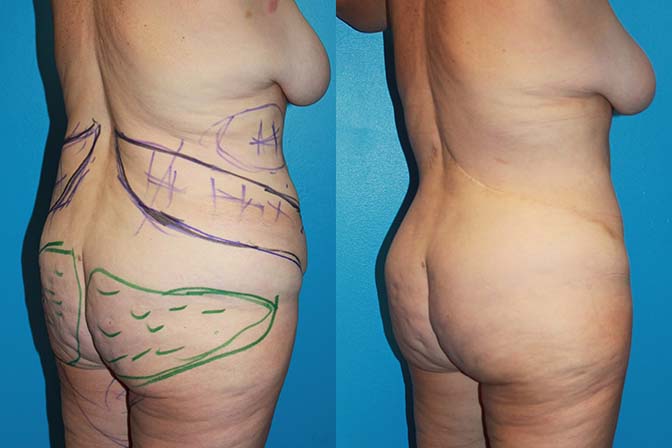Oblique Flankplasty as an Alternative to Lower Body Lift
Dennisj J. Hurwitz.
University of Pittsburgh, Pittsburgh, PA, USA.
BACKGROUND:The transverse lower body lift (LBL), reintroduced by Ted Lockwood in the 1990's, in either its high or low circumferential pattern, treats skin laxity of the lateral thigh and buttocks with the option of using the central excision site as a deepithelialized adipose fascial flap for buttock augmentation. While a reliable, low rate of complication operation, the LBL does not correct oversized flanks in males or create aesthetically pleasing deep waists in females. Also, lateral gluteal depressions are common adverse sequala and the buttock flap augmentations yield minimal added projection. In 2008, the author developed an alternative procedure called direct flank excision which has been further modified to Oblique Flankplasty. This is a retrospective report on the technique and follow up in 18 consecutive cases. METHODS: : Oblique Flankplasties are posterior extensions of lower transverse abdominoplasties. The elliptical excisions are centered over the protruding flank bulge from the Posterior Iliac crests to the junction of the twelfth rib and spine. The width of resection is determined by tissue gathering in both the standing and lateral decubitus positions. While prone, the inferior incision is made along the hip and obliquely through lower lumbar globular adipose to lumbodorsal fascia. The mobile lower flap of buttocks and lateral thigh is pulled to confirm the superior incision along the posterior costal margin. After that perimeter incision is made perpendicular down to Latissimus Dorsi and External Oblique fascia, the intervening island of excess tissue is excised to the muscular fascia. After precisely aligning the obliquely oriented excisions, the superficial layers of the SFS are approximated, preferable with double armed #2 Barbed absorbable sutured, with a bite that includes underlying fascia. Intradermal running and skin glue complete the closure. Buttock augmentation may be performed with lipoaugmentation. RESULTS: In these 18 cases. there have been no significant wound healing complications. One case that crossed the posterior midline required two needle aspirations of a seroma. There were no scar revisions. Secondary liposuction, lipoaugmentation or RFAL skin tightening was performed in 4 cases. In all cases the flank bulges were adequately treated in males and a pleasing narrowing of the waist accomplished in females (Fig. Result at 18 months). Thigh saddlebag deformity was corrected when indicated. There was a lateral buttock rounding rather that lateral gluteal depressions. Preoperative patient reluctance led to post-operative acceptance of low back obliquely oriented scars that uniformly flattened and faded over a year. Discussion: In properly selected patients, Oblique Flankplasty results in aesthetically appealing improvement in both men and women. In comparison to historical matched LBL cases, selected Flankplasty cases yield better lower torso contours. CONCLUSIONS: After Massive weight loss, pregnancy with aging, Oblique Flankplasty provide excellent lower body contours with a low rate of complications. 
Back to 2017 Program




